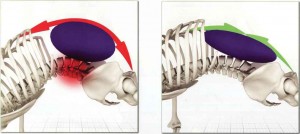 I am working my way up the body sharing my take on different muscles and their role in bending the back in yoga. This post focuses on the rectus abdominis muscle in Backbending poses. Backbending is not the best way to describe what we are attempting to do with this classification of poses. The body bends while the spine should lengthen. Spinal extension would be a better name but it lacks the same panache as backend.
I am working my way up the body sharing my take on different muscles and their role in bending the back in yoga. This post focuses on the rectus abdominis muscle in Backbending poses. Backbending is not the best way to describe what we are attempting to do with this classification of poses. The body bends while the spine should lengthen. Spinal extension would be a better name but it lacks the same panache as backend.
The alignment of your extremities determine whether your are lengthening or compressing the spine. There are only four muscles that connect the arms and legs to the spine and pelvis, and if they aren’t working as designed it is very hard to get the spine to lengthen as it is supposed to.
When backbends are done successfully the whole spine lengthens in two directions: it moves down from the middle of the lumbar towards the tailbone, or coccyx, and lengthens up from the middle of the lumbar to the head. When we do backbends that don’t serve our spine the base of the spine can’t move in the SI joint and the bones of the lumbar spine compress rather than extend.
The next, and probably last, of these posts detailing backbends will focus on the latissimus dorsi that connects the arms to the spine and pelvis. Today we are looking at the rectus abdominus, your crunches muscle. I like to think of backbends as sit-ups, a counter intuitive image that serves me well, if not my wife, who thinks it is a silly statement.
The rectus abdominis runs from the base of the ribcage to the pubic bone of the pelvis. There are two main factors that distinguish the rectus abdominis—if you believe my take on posture, that we all lean backwards and tuck our pelvis, the rectus abdominus is overly stretched and too long for its own good. The second factor is that the rectus abdominus tends to do the work of all the abs whether asked to or not. This is sometimes referred to as the “tyranny of the rectus”. All of the abdominal muscles are connected through tendons and fascia. They should all work in concert without one dominating the rest.
The unfortunate truth is that the rectus tends to work even when there is no need. I like to teach clients exercises that isolate muscles to show them what works and why. The rectus abdominus which functions to the draw the rib cage towards the pelvis and the pelvis towards the ribcage doesn’t need to engage if you are lying flat on your back and lift your feet gently off the floor. Even though it shouldn’t engage in such a simple action that doesn’t ask for the ribs to move closer to the pelvis, it tends to engage anyway at the expense of the deeper muscle (transverse Abdominis) that should do the buld of the work.
In backbending though the rectus abdominis has a vital and specific function which is where the sit-up image comes in. If the rectus abdominis doesn’t engage in a backbend shortening the distance between the rib cage and the pelvis, the back of the lumbar spine will compress and shorten no matter what the rest of your anatomy is doing. You can have the arms and legs perfectly aligned but if the rectus abdominis doesn’t engage successfully the front of the body will lengthen and the back of the body will shorten.
That is a bend in the back that we don’t want. If you think of wheel pose as a sit up you might create the proper environment to lengthen the back while bending the body.
***
